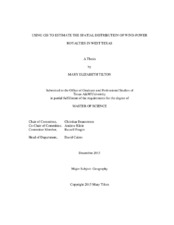| dc.description.abstract | Wind energy is one of the fastest growing sources of renewable energy in the United States, particularly in the Great Plains region. This remarkable expansion has been attributed to high social acceptance, a simple permitting system, renewable portfolio standards, and tax incentives. However, the extent of financial benefits of wind energy (royalties) to landowners is poorly known, and scholars have not yet estimated how royalties are distributed spatially. This research utilizes land parcel information in conjunction with County Appraisal District records for Nolan and Taylor Counties in west Texas; wind turbine (n = 1,746) location, name and nameplate capacity; and a royalty estimation. The research examines the spatial distribution of royalties, to compare local and absentee benefits, and to estimate the disparity in estimated royalty payments between landowners with turbines and those without who receive no direct financial benefits. The mean estimated royalty payment per turbine per year is $7,404 and total royalties for the wind-farms in the two counties is more than $11 million annually which is captured by approximately 3% of all rural landowners. Non-resident landowners with turbines, defined as those landowners who live more than twenty miles from their tax addresses (approximately 46% of total landowners), receive 47% of total royalties, with the majority (70%) of royalties received by non-residents in Texas, and 61% of royalties remaining in the two-county study area. When key components of the wind contract depress, the total mean estimated average royalty for the study site also depresses, with capacity factor having the most effect on royalties. More than 30% of landowners with turbines have some land tenure in effect, and 45% of royalties are distributed to this faction. Turbines, and therefore, royalties appear to be distributed unequally amongst rural landowners and parcel size is highly correlated to number of turbines and royalty payments. Many residents continue to welcome wind power despite the inequality of benefits, but more research is needed to determine what factors may affect public perceptions and how royalties may affect spending in the area. Future research should focus on how royalties are used. | en |


